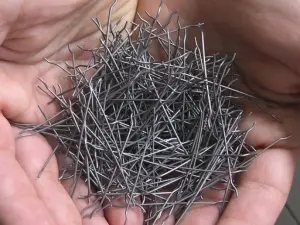Saad Iqbal | 🗓️Modified: November 24, 2017 | ⏳Read Time: 6 min | 👁Post Views: 1715
Cast In Situ is a term meaning a construction item or structural member like a beam or in this case a Pile that is to be constructed, assembled or poured at site rather than prefabrication in a factory. Generally in cast in place or cast in situ construction concrete is transported from a batch plant to site where it is poured and compacted into the formwork which is fixed in desired shape and dimensions at site.
 |
| Cast In Situ Pile Foundation is usually used in Flyovers and Bridges |
Cast in situ or cast-in-place
piles are those which are cast in position inside the ground; usually in such type of piles an auger drilling device or a drill bit is used to drill pit of required diameter and depth into the ground.
Also Read
Such type of device uses a helical screw blade usually called a “fighting blade” which acts as a screw conveyor to remove the drilled out material. In addition to auger drilling, an old technique called percussion drilling is also used for excavating the hole. In this technique a heavy cutting or hammering bit attached to a roper or cable is lowered in the open hole or inside a temporary casing.
After getting to some depth deep into the ground a temporary steel casing is lowered in the borehole to protect loose soil from falling in the borehole.
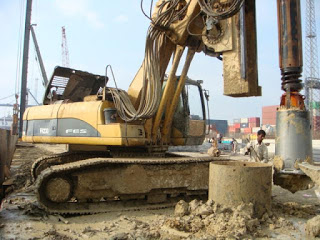 |
| Pile Auger Machine Credits : ougangroup |
The verticality of the casing is to be checked properly before proceeding. After achieving the desired depth reinforcement cage with vertical rebars and stiffeners is lowered inside the borehole, and hanging the upper part at the top. The concreting is usually done by Tremie method of concrete piling.
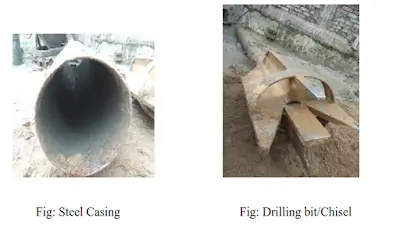 |
| Procedure of Cast in Situ Pile Foundation |
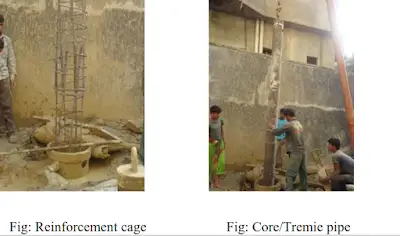 |
| Steel Cage Lowering and Tremie Pipe |
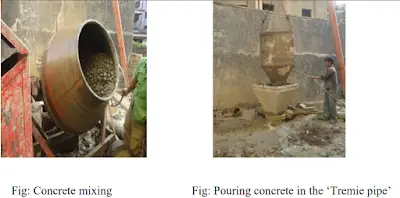 |
| Concrete Mixing and Pouring |
There are usually 6 types of cast in situ piles as below:-
1. Simplex Pile
2. Franki Pile
3. Vibro Pile
4. Vibro Expanded Pile
5. Raymond Pile
6. Mac Arthur Pedestal Pipe
Advantages of Cast In Situ Concrete Piles
- As explained above cast in situ piles are installed by pre-excavation, thus eliminating vibration due to driving as in case of driven piles.
- In housing area, by hammering in driving the piles may cause huge sound pollutions. In such areas cast in situ piling is more effective.
- In case of water logged area, cast in situ piling with permanent casing is more suitable.
- Cast in situ piles can fully utilize the skin friction resistance with the ground during design stages which cannot be considered as in case of driven piles which only uses the end bearing.
- The cast in situ concrete piles usually do not require any foreign materials and equipments and usually indigenous equipments and materials will suffice the need of a project thus making the cast-in-situ piles as a cheaper and adaptable type of pile foundation.
- Precast piles on the other hand are to be designed to cater the handling and driving stresses thereby increasing the reinforcement required which is not in the case of cast in situ piles thus reducing the amount of reinforcement needed.
- Cast in situ piles are connected above ground with a pile cap using a monolithic approach. The top ground is excavated upto pile cut off level from where the slushy low quality concrete is removed using hand hilty to get developed rebars into the pile cap.
- Due to this monolithic connection, cast in situ pile has an advantage of having more resistance to the earthquake and wind forces.
- Once the piles are casted no maintenance is needed.
- As the materials and machinery used are usually from the local community local contractors can do the job and not any serious skilled labor is needed for cast in situ piles.
- No serious attention is required for joints in cast in situ piles as compared with precast driven piles.
Disadvantages of Cast In Situ Piles
- As the pre-cast piles are manufactured in factories and assembly plants the controlling of quality and quantity is easy and can be ensured without a hack but in case of cast-in-situ piles it is very difficult to control mix as well quality of the concrete.
- The concrete during pouring of cast in situ piles is usually done from a height thus quality of work cannot be ensured.
- As the precast piles are casted in factories equipped with machinery and robots thus less labor is required in pre-cast piles but this is not the case of cast in situ piles which require intensive labor.
- In Cast in situ piles more concrete is consumed as at the site there is enough loss of concrete sometimes due to poor workmanship.
- After the concrete is poured in cast in situ piles it requires sufficient time to lapse for gaining the designed strength which requires time. Thus for speedy construction this cast in situ pile is not recommended.
- As the concrete quality is not uniform throughout the batch therefore on-site slump and strength test is usually done to ensure quality up to some extent.
- Pre-cast concrete piles can be casted in advance to save time of casting but this cannot be done as cast-in-situ piles are to be casted only after the auger has done its work.
- As all the work is carried out at site open conditions, weather plays a decisive role in quality as well as the pace of work. The mix design may needed to be revised and adjusted accordingly and heavy rains and floods might cause delay in the work.
Key Take a ways….?
Cast in situ piling is favorable than other piling process because there is not waste of time and materials so it is economical and can be cast into exact length. It can bear heavier load and transfer to the ground thus best option for low bearing soils.
After reading the advantages and disadvantages of cast in situ piles you can now easily decide which type of pile foundation would be suitable for your job. Every project has its own pros and cons that require precise judgmental approach for deciding the methodology and mechanism of construction process. But this step must be handled very professionally as the cost and economy of the project would be depending greatly on your this decision.






